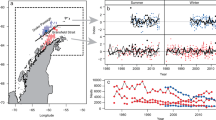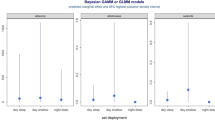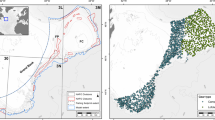Abstract
It is clear that discards from commercial fisheries are a key food resource for many seabird species around the world1,2,3,4,5,6,7,8. But predicting the response of seabird communities to changes in discard rates is problematic and requires historical data to elucidate the confounding effects of other, more ‘natural’ ecological processes. In the North Sea, declining stocks, changes in technical measures, changes in population structure9 and the establishment of a recovery programme for cod (Gadus morhua10) will alter the amount of fish discarded. This region also supports internationally important populations of seabirds11, some of which feed extensively, but facultatively, on discards, in particular on undersized haddock (Melanogrammus aeglefinus) and whiting (Merlangius merlangus)1,2,3. Here we use long-term data sets from the northern North Sea to show that there is a direct link between discard availability and discard use by a generalist predator and scavenger—the great skua (Stercorarius skua). Reduced rates of discarding, particularly when coupled with reduced availability of small shoaling pelagic fish such as sandeel (Ammodytes marinus), result in an increase in predation by great skuas on other birds. This switching of prey by a facultative scavenger presents a potentially serious threat to some seabird communities.
This is a preview of subscription content, access via your institution
Access options
Subscribe to this journal
Receive 51 print issues and online access
$199.00 per year
only $3.90 per issue
Buy this article
- Purchase on Springer Link
- Instant access to full article PDF
Prices may be subject to local taxes which are calculated during checkout


Similar content being viewed by others
References
Garthe, S., Camphuysen, C. J. & Furness, R. W. Amounts of discards by commercial fisheries and their significance as food for seabirds in the North Sea. Mar. Ecol. Prog. Ser. 136, 1–11 (1996)
Furness, R. W. Impacts of fisheries on seabird communities. Sci. Mar. 67(suppl. 2), 33–45 (2003)
Hudson, A. V. & Furness, R. W. The behaviour of seabirds foraging at fishing boats around Shetland. Ibis 131, 225–237 (1989)
Stratoudakis, Y., Fryer, R. J., Cook, R. M. & Pierce, G. J. Fish discarded from Scottish demersal vessels: Estimators of total discards and annual estimates for targeted gadoids. ICES J. Mar. Sci. 56, 592–605 (1999)
Bearhop, S. et al. Annual variation in great skua diets: the importance of commercial fisheries and predation on seabirds revealed by combining dietary analyses. Condor 103, 802–809 (2001)
Thompson, K. R. Quantitative analysis of the use of discards from squid trawlers by black-browed albatrosses Diomedea melanophris in the vicinity of the Falkland Islands. Ibis 134, 11–21 (1992)
Arcos, J. M. & Oro, D. Changes in foraging range of Audouin's gulls Larus audouinii in relation to a trawler moratorium in the western Mediterranean. Colonial Waterbirds 19, 128–131 (1996)
Oro, D. The effects of trawler discard availability on the egg-laying and the breeding success of the lesser black-backed gull Larus fuscus in the western Mediterranean. Mar. Ecol. Prog. Ser. 132, 43–46 (1996)
ICES. Report of the ICES Advisory Committee on Fishery Management, 2002. Cooperative Research Report No. 255 (ICES, Copenhagen, Denmark, 2002)
ICES Advises Zero Catches of Cod and Other Fish Stocks. ICES Press Release 20 October 2003; at 〈http://www.ices.dk/aboutus/pressrelease/ACFMautumn2003.pdf〉 (2003).
Lloyd, C. S., Tasker, M. L. & Partridge, K. The Status of Seabirds in Britain and Ireland (Poyser, London, 1991)
Alverson, D. L., Freeberg, M. H., Murawski, S. A. & Pope, J. G. A Global Assessment of Fisheries Bycatch and Discards. FAO Fisheries Technical Paper No. 339 (1994).
Hüppop, O. & Wurm, S. Effects of winter fishery activity on resting numbers, food and body condition of large gulls Larus argentatus and L. marinus in the south-eastern North Sea. Mar. Ecol. Prog. Ser. 194, 241–247 (2000)
Russell, J. O. & Montevecchi, W. A. Predation on adult puffins Fratercula arctica by great black-backed gulls Larus marinus at a Newfoundland colony. Ibis 138, 791–794 (1996)
Hamer, K. C., Furness, R. W. & Caldow, R. W. G. The effects of changes in food availability on the breeding ecology of great skuas Catharacta skua in Shetland. J. Zool. Lond. 223, 175–188 (1991)
Phillips, R. A., Thompson, D. R. & Hamer, K. C. The impact of great skua predation on seabird populations at St Kilda: a bioenergetics model. J. Appl. Ecol. 36, 218–232 (1999)
Klomp, N. I. & Furness, R. W. Non-breeders as a buffer against environmental stress: declines in numbers of great skuas on Foula, Shetland, and prediction of future recruitment. J. Appl. Ecol. 29, 341–348 (1992)
Regehr, H. M. & Montevecchi, W. A. Interactive effects of food shortage and predation on breeding failure of black-legged kittiwakes: effects of fisheries activities and implications for indicator species. Mar. Ecol. Prog. Ser. 155, 249–260 (1996)
Catry, P., Phillips, R. A., Hamer, K. C., Ratcliffe, N. & Furness, R. W. The incidence of nonbreeding by adult great skuas and parasitic jaegers from Foula, Shetland. Condor 100, 448–455 (1998)
Heubeck, M., Mellor, R. M., Harvey, P. V., Mainwood, A. R. & Riddington, R. Estimating the population size and rate of decline in kittiwakes Rissa tridactyla breeding in Shetland 1981–97. Bird Study 46, 48–61 (1999)
Oro, D. & Furness, R. W. Influences of food availability and predation on survival of kittiwakes. Ecology 83, 2516–2528 (2002)
Furness, R. W. Management implications of interactions between fisheries and sandeel-dependent seabirds and seals in the North Sea. ICES J. Mar. Sci. 59, 261–269 (2002)
ICES. Report of the Working Group on the assessment of demersal stocks in the North Sea and Skagerrak. ICES CM 1998/Assess: 7 (ICES, Copenhagen, Denmark, 1998)
Votier, S. C., Bearhop, S., MacCormick, A., Ratcliffe, N. & Furness, R. W. Assessing the diet of great skuas Catharacta skua using five different techniques. Polar Biol. 26, 20–26 (2003)
Härkönen, T. Guide to the Otoliths of the Bony Fishes of the Northeast Atlantic (Danbiu ApS, Hellerup, Denmark, 1986)
Furness, R. W. & Hislop, J. R. G. Diets and feeding ecology of Great Skuas Catharacta skua during the breeding season in Shetland. J. Zool. Lond. 195, 1–23 (1981)
Harvey, P., Gear, S., Swale, J. & Upton, A. in Shetland Bird Report 2000 (ed. Pennington, M.) 99–102 (Shetland Bird Club, Shetland, UK, 2001)
Croxall, J. P. & Rothery, P. in Bird Population Studies: Relevance to Conservation and Management (eds Perrins, C. M., Lebreton, J.-D. & Hirons, G. J. M.) 272–296 (Oxford Univ. Press, Oxford, UK, 1991)
Snow, D. W. & Perrins, C. M. The Birds of the Western Palearctic, Concise Edition Vol. 1 (Oxford Univ. Press, Oxford, UK, 1998)
Acknowledgements
We thank S. Humphries, N. Ratcliffe, A. Kelly and S. Waldron for assistance and discussion; and all those who helped over the years to collect prey remains at Foula. We thank the Fishery Research Service, Aberdeen, for providing Shetland sandeel VPA data. The research was supported by the Shetland Oil Terminal Environmental Advisory Group (SOTEAG) and by the European Commission contract ‘Discbird’. S.B. is funded by a Natural Environment Research Council (NERC) postdoctoral fellowship. P.C. is funded by the Fundação para Ciência e a Tecnologia (FCT), Portugal.
Author information
Authors and Affiliations
Corresponding authors
Ethics declarations
Competing interests
The authors declare that they have no competing financial interests.
Rights and permissions
About this article
Cite this article
Votier, S., Furness, R., Bearhop, S. et al. Changes in fisheries discard rates and seabird communities. Nature 427, 727–730 (2004). https://doi.org/10.1038/nature02315
Received:
Accepted:
Issue Date:
DOI: https://doi.org/10.1038/nature02315
This article is cited by
-
Model projections reveal a recent decrease in a yellow-legged gull population after landfill closure
European Journal of Wildlife Research (2023)
-
GPS tracking reveals landfill closures induce higher foraging effort and habitat switching in gulls
Movement Ecology (2021)
-
Long-term inter- and intraspecific dietary variation in sibling seabird species
Marine Biology (2021)
-
Foraging movements of breeding Kelp Gulls in South Africa
Movement Ecology (2020)
-
Long-term trends in albatross diets in relation to prey availability and breeding success
Marine Biology (2020)
Comments
By submitting a comment you agree to abide by our Terms and Community Guidelines. If you find something abusive or that does not comply with our terms or guidelines please flag it as inappropriate.



